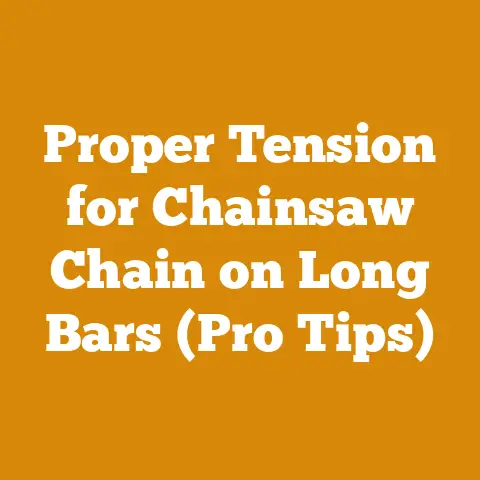Oregon Chain vs Stihl: Best Choice for Woodcutting (5 Expert Tips)
Are you standing at the crossroads of woodcutting, torn between the legendary Oregon chain and the mighty Stihl?
I’ve been there, axe in hand, pondering the very same question.
Let’s chop through the confusion and get to the heartwood of the matter!
Oregon Chain vs. Stihl: Best Choice for Woodcutting (5 Expert Tips)
The choice between Oregon and Stihl chainsaw chains is a classic debate in the woodcutting world.
Both brands offer high-quality products, but their strengths and weaknesses can make one a better fit for your specific needs.
I’ve spent countless hours in the field, felling trees and processing firewood with both, and I’m here to share my experiences and insights.
This guide will walk you through key considerations to help you make the right decision.
1. Understanding the Basics: Chain Anatomy and Terminology
Before diving into the specifics of Oregon and Stihl, let’s establish a common understanding of chainsaw chain anatomy.
A chainsaw chain isn’t just a loop of metal; it’s a complex assembly of interconnected parts, each playing a vital role in the cutting process.
Cutters: These are the teeth that do the actual cutting.
They come in various shapes and sizes, each designed for different cutting tasks.Rakers (Depth Gauges): Located in front of each cutter, rakers control the depth of the cut.
They prevent the cutters from taking too big of a bite, which can cause the saw to bog down or kickback.-
Tie Straps: These connect the cutters and rakers, providing the structural integrity of the chain.
-
Drive Links: These fit into the guide bar groove and engage with the sprocket, driving the chain around the bar.
Gauge: The thickness of the drive links determines the gauge of the chain.
It must match the gauge of your chainsaw bar.
Common gauges include .043″, .050″, .058″, and .063″.Pitch: The distance between three rivets divided by two.
Common pitches include 3/8″ LP (Low Profile), .325″, 3/8″, and .404″.
Why is this important? Knowing these terms will help you understand the specifications of each chain and how they relate to your chainsaw and cutting needs.
For example, using the wrong gauge chain on your bar can damage both the chain and the bar.
I once tried to force a .058″ chain onto a .050″ bar.
The result?
A ruined chain, a scratched bar, and a lesson learned the hard way!
2. Oregon Chainsaw Chains: A Legacy of Innovation
Oregon is a name synonymous with chainsaw chains.
Founded in 1947, they have a long history of innovation and are a leading manufacturer of saw chain and related products.
They offer a wide variety of chains to suit different applications and skill levels.
Oregon’s Strengths:
- Variety: Oregon offers a vast selection of chains, catering to everything from light-duty homeowner tasks to heavy-duty professional logging.
- Availability: Oregon chains are widely available at hardware stores, farm supply stores, and online retailers.
- Price: Generally, Oregon chains are more affordable than Stihl chains.
- Innovation: Oregon has been at the forefront of chain technology, introducing features like low-vibration designs and improved cutting efficiency.
-
Popular Oregon Chains:
-
Oregon S52 AdvanceCut: A popular choice for homeowners and occasional users, offering good performance at a reasonable price.
It features a low-kickback design for added safety. - Oregon 72LPX: A professional-grade chain designed for fast cutting and durability.
It’s a favorite among loggers and experienced woodcutters. - Oregon 91PX: A low-vibration chain ideal for smaller chainsaws and users who prioritize comfort and reduced fatigue.
My Experience with Oregon: I’ve used Oregon chains extensively over the years.
I remember one particularly challenging job clearing a heavily overgrown lot.
The Oregon 72LPX chain on my Husqvarna 372XP powered through thick brush and hardwood with ease.
Its aggressive cutting action and durability were essential for completing the project efficiently.
The key to getting the most out of an Oregon chain, I’ve found, is to choose the right one for the job and to keep it properly sharpened.
3. Stihl Chainsaw Chains: Precision Engineering and Performance
Stihl is another powerhouse in the chainsaw industry.
Known for their high-quality chainsaws, they also produce their own line of chains that are designed to work seamlessly with their saws.
Stihl’s Strengths:
- Precision: Stihl chains are manufactured to exacting standards, ensuring consistent performance and durability.
- Quality: Stihl chains are made from high-quality steel and undergo rigorous testing to meet Stihl’s stringent standards.
- Performance: Stihl chains are known for their smooth cutting action and ability to hold an edge.
- Compatibility: Stihl chains are designed to work optimally with Stihl chainsaws, ensuring maximum performance and longevity.
-
Popular Stihl Chains:
-
Stihl Rapid Micro (RM): A versatile chain suitable for a wide range of cutting tasks.
It offers a good balance of cutting speed, smoothness, and durability. - Stihl Rapid Super (RS): A high-performance chain designed for professional use.
It features a square-cornered cutter that delivers aggressive cutting action. - Stihl Picco Micro (PM): A low-vibration chain ideal for smaller chainsaws and users who prioritize comfort and reduced fatigue.
My Experience with Stihl: I had the opportunity to work with a Stihl MS 462 C-M chainsaw equipped with a Stihl Rapid Super chain during a timber harvesting project.
The combination was a force to be reckoned with.
The chain sliced through large diameter logs with remarkable speed and precision.
I was particularly impressed with how well the chain held its edge, even after prolonged use.
The downside?
Stihl chains can be more expensive and harder to find outside of authorized Stihl dealers.
4. Key Differences: Oregon vs. Stihl Chains
While both Oregon and Stihl produce excellent chainsaw chains, there are some key differences to consider:
Steel Quality: One area where Stihl often has an edge is in the quality of the steel used in their chains.
Stihl typically uses a higher grade of steel, which can result in a chain that holds its edge longer and is more resistant to wear and tear.
However, Oregon offers a wide range of steel qualities depending on the specific chain model.
Sharpening: I’ve found that Oregon chains are generally more forgiving to sharpen, especially for beginners.
Stihl chains, on the other hand, require more precise sharpening to maintain their optimal cutting performance.
This is due to the more complex cutter designs found on many Stihl chains.
Compatibility: While you can technically use an Oregon chain on a Stihl chainsaw (and vice versa), you’ll generally get the best performance by using a Stihl chain on a Stihl saw and an Oregon chain on a non-Stihl saw.
This is because Stihl chains are specifically engineered to work in harmony with Stihl’s saw designs.
5. Choosing the Right Chain: 5 Expert Tips
So, which chain is right for you?
Here are five expert tips to help you make the best decision:
Consider Your Chainsaw: What brand and model of chainsaw do you own?
If you own a Stihl chainsaw, you may want to consider using a Stihl chain to ensure optimal performance and compatibility.
If you own a non-Stihl saw, an Oregon chain may be a better choice.Assess Your Cutting Needs: What types of wood will you be cutting?
Will you be doing light-duty tasks like trimming branches or heavy-duty tasks like felling trees?
If you’re doing light-duty tasks, a less expensive chain like the Oregon S52 or Stihl Picco Micro may be sufficient.
If you’re doing heavy-duty tasks, you’ll want a more durable and aggressive chain like the Oregon 72LPX or Stihl Rapid Super.Evaluate Your Skill Level: Are you an experienced woodcutter or a beginner?
If you’re a beginner, you may want to start with a low-kickback chain like the Oregon S52 or Stihl Picco Micro.
These chains are designed to be more forgiving and less prone to kickback.
If you’re an experienced woodcutter, you may prefer a more aggressive chain that offers faster cutting speeds.Factor in Your Budget: How much are you willing to spend on a chainsaw chain?
Oregon chains are generally more affordable than Stihl chains.
If you’re on a tight budget, an Oregon chain may be the better choice.Read Reviews and Compare Specs: Before making a purchase, read reviews from other users and compare the specifications of different chains.
Pay attention to factors like chain pitch, gauge, cutter type, and recommended bar length.
Example Scenario: Let’s say you own a Stihl MS 271 chainsaw and primarily use it for cutting firewood.
You’re an experienced woodcutter and want a chain that offers a good balance of cutting speed and durability.
In this case, the Stihl Rapid Micro (RM) chain would likely be a good choice.
It’s designed to work well with Stihl chainsaws, offers good performance, and is durable enough for regular firewood cutting.
The Importance of Proper Maintenance: No matter which chain you choose, proper maintenance is essential for maximizing its performance and lifespan.
This includes:
Sharpening: Keep your chain sharp by filing the cutters regularly.
A dull chain is not only less efficient but also more dangerous.Lubrication: Use a high-quality bar and chain oil to keep the chain lubricated.
This will reduce friction and wear, extending the life of the chain.Tensioning: Maintain proper chain tension.
A chain that is too loose can derail, while a chain that is too tight can overheat and break.Cleaning: Clean your chain regularly to remove sawdust and debris.
This will help prevent rust and corrosion.
I’ve seen firsthand the difference that proper maintenance can make.
A well-maintained chain can last significantly longer and perform much better than a neglected one.
I remember a time when I was cutting firewood with a friend who had never sharpened his chain.
His saw was struggling to cut through even small logs.
After I showed him how to sharpen the chain, his saw was like a new machine!
Safety First: Always wear appropriate safety gear when operating a chainsaw, including:
-
Eye Protection: Safety glasses or a face shield to protect your eyes from flying debris.
-
Hearing Protection: Earplugs or earmuffs to protect your hearing from the loud noise of the chainsaw.
-
Gloves: Heavy-duty gloves to protect your hands from cuts and abrasions.
-
Chaps: Chainsaw chaps to protect your legs from accidental cuts.
-
Boots: Steel-toed boots to protect your feet from falling logs and other hazards.
Beyond Chains: Other Factors to Consider: While the chain is a crucial component of your chainsaw, it’s important to remember that other factors can also affect your woodcutting performance.
These include:
-
Chainsaw Power: A more powerful chainsaw will be able to handle larger diameter logs and tougher wood.
-
Bar Length: The length of your chainsaw bar should be appropriate for the size of the trees you’ll be cutting.
-
Chain Type: Different chain types are designed for different cutting tasks.
-
Cutting Technique: Proper cutting technique can improve your efficiency and reduce the risk of kickback.
My Final Thoughts: Choosing the right chainsaw chain is a personal decision that depends on your individual needs and preferences.
Both Oregon and Stihl offer excellent chains, but their strengths and weaknesses can make one a better fit for you.
By considering the factors outlined in this guide, you can make an informed decision and choose the chain that will help you get the job done safely and efficiently.
I hope this guide has been helpful.
Remember, the best way to find the perfect chain for you is to experiment and see what works best for your chainsaw and your cutting style.
Happy cutting!






